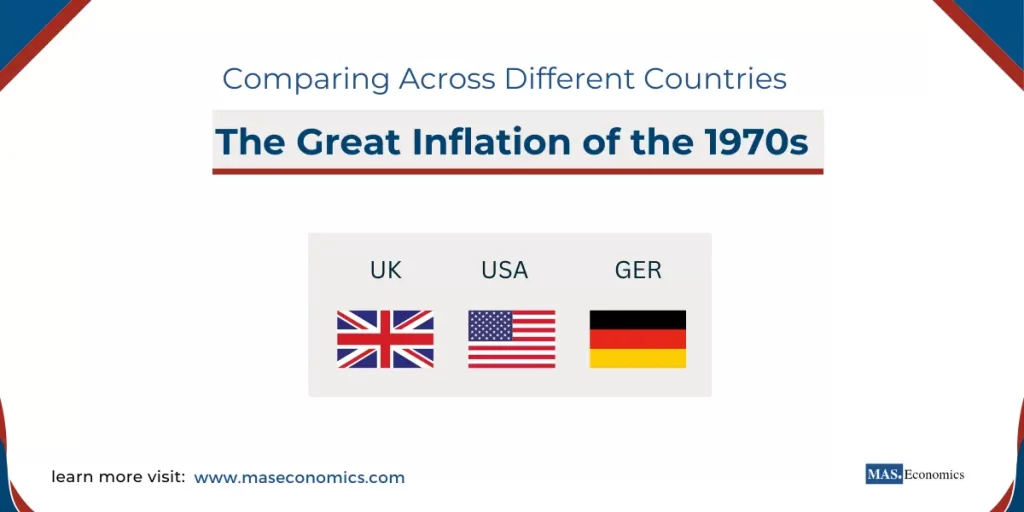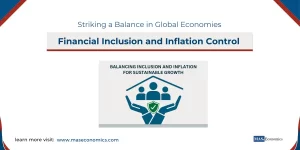The 1970s witnessed an unprecedented surge in inflation across most of the developed world. This period, commonly referred to as the “Great Inflation,” was characterized by skyrocketing prices, economic stagnation, and frequent energy crises. The inflationary shocks of the decade affected nearly every major Western economy, but each country responded in its own way, influenced by unique political, social, and economic factors.
To better understand how different Western economies addressed the inflation challenges of the 1970s, the following table provides a comparative overview of the issues faced, policy measures taken, and the resulting outcomes in countries like Italy, West Germany, the United States, and the United Kingdom.
| Country | Problems Faced During Inflation | Policy Measures Implemented | Outcomes & Challenges |
|---|---|---|---|
| Italy | High public spending, political instability, structural weaknesses, fiscal deficits, and wage indexation. | Deficit financing, wage indexation (“scala mobile”), limited central bank independence. | Persistent inflation cycle, political instability, high inflation compared to Western Europe. |
| West Germany | Inflationary pressures from global energy crises, maintaining export competitiveness. | Conservative monetary policy, interest rate hikes, coordinated wage growth and productivity. | Moderate inflation, slowed growth, cooperation between labor and employers. |
| United States | Rising government expenditure (Vietnam War, “Great Society” programs), oil shocks, increased money supply. | Expansionary monetary policy initially, aggressive interest rate hikes under Paul Volcker. | Deep recession in early 1980s, but successfully reduced inflation at the cost of high unemployment. |
| United Kingdom | Strong trade unions, adversarial labor relations, oil price shocks, fragmented industries. | Incomes policies, wage and price controls, IMF assistance. | Failed incomes policies, labor unrest, IMF intervention, “Winter of Discontent.” |

|
|||
Italy
Italy’s experience with inflation in the 1970s was marked by a combination of high public spending, political instability, and structural economic weaknesses. During this period, the Italian economy was heavily reliant on state intervention, with significant public ownership across various industries. This led to inefficiencies and an inability to adapt quickly to global economic changes, such as the oil price shocks.
Inflation in Italy was exacerbated by a combination of fiscal deficits and labor market rigidity. The government often resorted to deficit financing to support public enterprises and social welfare programs, which increased the money supply and fueled inflation. Moreover, wage indexation policies, known as “scala mobile,” automatically adjust wages to keep pace with inflation, thereby embedding inflationary expectations into the economy and creating a persistent cycle of rising prices.
The Bank of Italy struggled to maintain control over monetary policy, often yielding to political pressures that called for accommodative policies to support growth and employment. Unlike West Germany, Italy did not have the same level of central bank independence, which hindered its ability to implement effective anti-inflationary measures. The combination of political instability and fiscal profligacy meant that Italy faced higher inflation compared to its Western European counterparts, highlighting the critical role of strong institutions and disciplined fiscal policy in managing inflation.
West Germany
Unlike Italy, the United States, and the United Kingdom, West Germany approached the inflation of the 1970s with a much more conservative monetary policy, centered on the Bundesbank’s steadfast commitment to price stability. West Germany’s economic model was fundamentally based on maintaining export competitiveness, and this principle informed much of its macroeconomic management during the inflationary crisis.
The Bundesbank responded to the inflationary pressures of the early 1970s by tightening monetary policy significantly. Interest rates were raised to control the money supply and curb inflation, which contrasted sharply with the more expansionary policies in other countries. This approach led to a slowdown in economic growth but managed to keep inflation at a relatively moderate level compared to other Western economies.
Another significant aspect of West Germany’s approach was the coordination between wage growth and productivity. Unlike in the UK, where wage negotiations were highly fragmented, Germany’s trade unions worked more closely with employers and the government to ensure that wage increases were in line with productivity growth. This cooperation helped to prevent a wage-price spiral and kept inflation in check. The success of West Germany’s approach demonstrated the effectiveness of a disciplined monetary policy combined with a cooperative labor environment.
The United States
During the 1970s, the United States faced a turbulent economic climate, influenced by a mix of domestic and international pressures. One of the most significant drivers of inflation in the U.S. was the increasing government expenditure due to both the Vietnam War and President Lyndon Johnson’s “Great Society” programs. These initiatives fueled demand, but the constrained supply side struggled to keep up, setting off inflationary pressures.
Monetary policy during this time played a significant role in both fueling and eventually addressing inflation. In the early part of the decade, the Federal Reserve adopted an expansionary monetary stance to combat economic slowdown, leading to an increase in the money supply. This was a significant factor behind the inflation surge, particularly after the oil crisis of 1973, which sent shockwaves through the global economy.
By the late 1970s, the Federal Reserve, under the leadership of Paul Volcker, took a radically different approach. Volcker’s administration aimed to curb inflation through aggressive interest rate hikes, which reached levels unprecedented in modern American history. The outcome was a deep recession in the early 1980s but ultimately a reduction in inflation, albeit at the cost of high unemployment and slower economic growth. This strategy, which relied on sharply restricting the money supply, underscored the importance of central bank independence in fighting inflation, a lesson that remains relevant today.
United Kingdom
The United Kingdom experienced some of the most pronounced inflationary episodes of the 1970s. A key challenge was the fragmented and often adversarial labor relations that dominated British industry. Wage inflation was rampant, fueled by a strong trade union movement that demanded higher pay in response to rising prices. These demands, coupled with the country’s reliance on industries that were less competitive globally, created a vicious cycle of cost-push inflation.
In an attempt to control inflation, successive governments implemented a series of incomes policies, which included wage and price controls. These measures, although intended to provide a counterbalance to the inflationary pressures, often backfired. The Industrial Relations Act of 1971, for instance, sought to regulate strikes and manage wage disputes but led to increased labor unrest. As inflation continued to spiral, the government under Prime Minister Edward Heath was eventually forced to introduce a wage freeze, only to face political backlash and subsequent electoral defeat.
The oil price shocks of the 1970s further complicated matters for the United Kingdom, and by the mid-1970s, the country had to turn to the International Monetary Fund (IMF) for assistance. This period of economic turmoil culminated in what became known as the “Winter of Discontent” in 1978-79, marked by widespread strikes and public dissatisfaction. The situation highlighted the challenges of managing inflation in the face of weak political consensus and fragmented labor structures.
Key Takeaways from the Great Inflation
The differing experiences of Italy, West Germany, the United States, and the United Kingdom during the Great Inflation of the 1970s offer important insights into the management of inflationary pressures:
Central Bank Independence
West Germany’s relative success in controlling inflation underscores the importance of a central bank that operates independently of political pressures. The Bundesbank’s focus on price stability provided a stark contrast to the more politically influenced monetary policies of the United States and Italy.
Labor Relations and Wage Controls
The experiences of the United Kingdom and Italy highlight how labor market dynamics can either exacerbate or mitigate inflation. Fragmented and adversarial labor relations in the UK led to significant wage pressures, while West Germany’s coordinated approach helped maintain stability.
Fiscal Discipline
Italy’s struggle with inflation was compounded by fiscal mismanagement and high public debt. The importance of maintaining a balanced fiscal policy, especially during periods of economic shock, cannot be overstated. The contrast between Italy’s deficit-financed expenditures and West Germany’s more disciplined fiscal approach is a lesson in the dangers of unchecked government spending.
Managing Expectations
Inflation is as much about public expectations as it is about monetary supply. The failure of income policies in the United Kingdom, which were unable to anchor expectations, contrasts with the success of Volcker’s tight monetary policy in the United States, which ultimately restored confidence in price stability, albeit at a significant short-term cost.
Conclusion
The Great Inflation of the 1970s was a defining period that shaped modern economic policy. The varying approaches taken by Italy, West Germany, the United States, and the United Kingdom provide a rich tapestry of lessons for managing inflation today. Central bank independence, fiscal prudence, labor market coordination, and the effective management of inflationary expectations are all crucial components of a successful anti-inflationary strategy.
For modern policymakers, the key takeaway is the importance of proactive and coordinated economic management. Whether dealing with supply shocks, such as rising energy prices, or navigating the complexities of labor relations, the experiences of the 1970s highlight the need for flexibility, strong institutions, and a clear focus on maintaining economic stability. By learning from the successes and failures of the past, we can better prepare for the inflationary challenges of the future.
FAQs
What were the main causes of the Great Inflation of the 1970s?
The Great Inflation of the 1970s was driven by multiple factors, including rising oil prices due to oil embargoes, expansive fiscal policies (e.g., increased government spending), and, in many countries, an increase in the money supply through loose monetary policy. These factors were exacerbated by labor demands and, in some cases, weak institutional controls over inflation.
How did different countries respond to inflation during this period?
Each country adopted unique strategies. Italy relied on deficit financing and wage indexation, which fueled further inflation. West Germany employed a conservative monetary policy, maintaining price stability. The United States initially expanded the money supply but later adopted aggressive interest rate hikes under Federal Reserve Chair Paul Volcker to curb inflation. The United Kingdom attempted income policies and wage controls, but these measures were largely unsuccessful.
Why did Italy experience persistent inflation compared to other countries?
Italy’s reliance on deficit financing, wage indexation policies like “scala mobile,” and political pressures on the Bank of Italy hindered effective inflation control. Lack of central bank independence and a structural reliance on public spending contributed to persistent inflation, making it challenging to stabilize prices.
How did West Germany manage to keep inflation lower than other countries?
West Germany’s Bundesbank adopted a strict monetary policy focused on price stability, raising interest rates to control inflation. Furthermore, cooperation between labor unions, employers, and the government helped align wage growth with productivity, preventing a wage-price spiral and maintaining relative price stability.
What role did central bank independence play in managing inflation?
Central bank independence was crucial for effectively controlling inflation. West Germany’s Bundesbank was largely independent, allowing it to prioritize price stability without political interference. In contrast, Italy and, initially, the United States faced political pressures that influenced monetary policy, complicating inflation control efforts.
How did wage and labor relations affect inflation in the United Kingdom?
The UK’s fragmented labor relations and strong union influence led to frequent wage demands, contributing to wage inflation and a wage-price spiral. Attempts to control wages through income policies and wage freezes failed, leading to labor unrest and economic instability, as seen during the “Winter of Discontent.”
What was the impact of the United States’ aggressive interest rate hikes?
Under Paul Volcker, the U.S. Federal Reserve sharply increased interest rates to curb inflation, leading to a deep recession but successfully reducing inflation in the long term. This policy highlighted the importance of decisive action in combating inflation, although it came with the cost of higher unemployment and economic slowdown.
Thanks for reading! Share this with friends and spread the knowledge if you found it helpful.
Happy learning with MASEconomics



